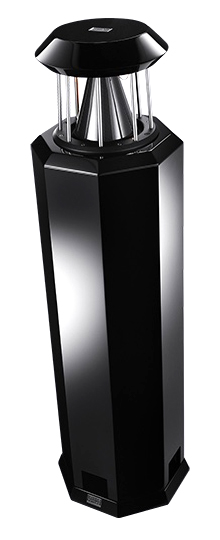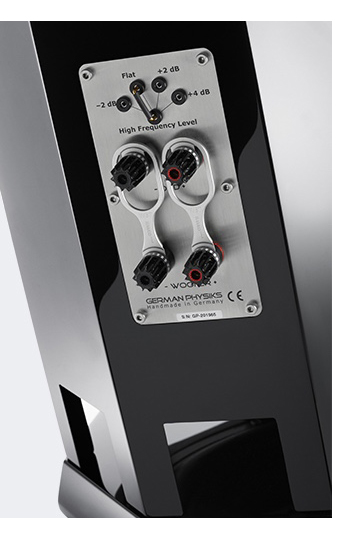The German Physiks HRS-130 Speakers Vanishing Act
By Jeff Dorgay It only seems fitting to play Lou Reed’s “Vanishing Act” while listening to these marvels of German Engineering. The difference in his haunting solo vocal on this track compared to listening to a more traditional cabinet speaker is astounding.
It only seems fitting to play Lou Reed’s “Vanishing Act” while listening to these marvels of German Engineering. The difference in his haunting solo vocal on this track compared to listening to a more traditional cabinet speaker is astounding.
With the lights low in the listening room, it comes close to feeling like Reed is right there, standing about three feet in front of my listening chair. The overtones in his deep voice, awash in texture, feeling correct from a height standpoint as well, proves to be a moving experience. And that’s just the first track.
About five years ago I had the privilege to listen to the smaller Ultimate 2 loudspeakers and came away amazed at the enormous sound field these speakers recreated in my listening room. You can read that review here: (http://www.tonepublications.com/spotlight/review-german-physiks-unlimited-mk-ii-speakers/) The Ultimates do not use the advanced carbon fiber DDD drivers that the HRS-130s do, and they have a smaller, 8-inch woofer.
Like the HRS-130 you see there, they also featured the carbon fibre driver. The earlier HRS-120s I lived with for a while featured the earlier metal DDD driver. They were intriguing, but the metal driver still had a bit of a harshness that you don’t quite realize until you hear the carbon fiber driver – then you can’t unhear it.
As with the Ultimate 2s, or any other German Physiks speakers, one of their greatest strengths is the ability to vanish in the room. The omnidirectional DDD driver handles all frequencies from 220hz to the maximum of 24khz, leaving the delicate midrange notes untouched by the transition, distortion and phase anomalies of a crossover network. Even though the driver is characterized as “omnidirectional,” it recreates space with very precise cues.
Fortunately, the HRS-130s new cabinet, with the black gloss polyester finish (also available in white) features corners that are slightly more rounded, giving this uniquely shaped speaker a bit more sex appeal. Personally, I love the black cabinet with the black carbon fiber in the DDD driver. The 10” woofer is downward firing, and the entire enclosure barely takes up a 13” square footprint. A pair of HRS-130s will set you back about $22,000 in the standard finish. Upgraded colors, wood finish and even full carbon fiber are available at extra cost. I know I’d go for all carbon fiber, but I’ve always had no problem spending your money.
Back to the big Sound
Staying in the blues groove, next up is Keith Richards “Wicked as it Seems.” About ten seconds into the track, when Richards’ signature greasy, growling guitar enters the picture, it not only has the necessary amount of dynamic punch and tonal saturation, it comes forward in the mix, occupying its own space. It feels as if Richards walked out from behind a stack of amplifiers and walked right out in front, attacking you with his presence – incredible. Still, with not enough blues under the belt, I quickly switch to Michael Burks “I Smell Smoke.” If you haven’t had the chance to hear this late, great blues master from my hometown (Milwaukee, Wisconsin, yeah) play, he was an absolute powerhouse, dominating whatever stage he played. Again thanks to the instantaneous acceleration and fatigue-free presentation of the DDD driver, Burks’ guitar tears through the air between the speakers, and thanks to the perfect integration of woofer and DDD driver, the accompanying bass line is just as engaging. There’s no question that these speakers can rock.
It wouldn’t be an audiophile review without some female vocals, would it? Fortunately, Larry Borden, the GP importer hosting the demo enjoys Ella Fitzgerald as much as I do, and a quick romp through “Miss Otis Regrets” is lovely. The precision of this driver is immediately showcased, capturing every bit of nuance that Fitzgerald is famous for, without any hint of harshness to take away from the magic that is recreated here.
Thanks to a full complement of Merrill Audio electronics and EMM Labs DAC, the entire system plays to the HRS 130’s lightning fast transient response. Should you like the transparency and immediacy of an electrostatic speaker, you’ll probably appreciate the similar characteristics that the German Physiks speakers offer. But that’s where it ends. While the HRS-130 has the same transparency that an ESL offers, the DDD driver has such wide dispersion, you can enjoy these speakers anywhere in the room. While walking around Borden’s room, it’s evident that the spot between the speakers is the place to be, yet there is no dead spot in the rest of the room. These are speakers that can be enjoyed by everyone when you have a musical gathering.
Listening to track after track of heavy rock proves that these speakers have the extra punch that the smaller German Physiks speakers can’t quite muster. I won’t make the Spinal Tap reference here, but… Winding up my listening sessions with the title track from David Bowie’s Aladdin Sane, I’m drawn back into what makes these speakers so special; the way they can unravel a multifaceted recording is indeed special. This track combines a driving bass line, a highly discordant piano, and crunchy guitars with Bowie’s sultry signature voice. On a less than awesome set of speakers, it just goes flat, yet through the HRS 130s, I’m enveloped with a rich musical experience.
Where most panels provide a more diffuse rendering of the sonic landscape that they render, the HRS 130, with the DDD driver is a different animal. More pronounced dynamically than a panel, they still don’t set you back in the chair like a great all-cone speaker does, yet they offer better integration between the woofer and DDD driver than most hybrid ESL designs I’ve lived with.
Bass response is solid, and the spec sheet claims response down to 29hz. While we didn’t have any test gear at our disposal, a run through a number of Pink Floyd tracks reinforces the notion that there is plenty of LF information available with the HRS 130. Even in Borden’s large (approx. 22 x 30 foot) room, I feel no need for a subwoofer when enjoying these speakers – even when playing Kruder & Dorfmeister at high volume.
With an 86db sensitivity rating, it’s probably best to have some power on tap, and the Merrill Audio Veritas amplifiers producing 400 watts per channel into 8 ohms keep these speakers well controlled.
Setup is easy. The wide dispersion of the DDD driver makes for easier placement than box or panel speakers. While Borden has his pair set up to perfection, I recall when using the Ultimates, if you can spend about 20 minutes with your German Physiks speakers, you will not only get the smoothest bass response, optimum placement will give you the most linear tonal response. I suspect the HRS 130 is similar in this respect. But there’s never been an easier speaker in memory that works well if you just throw it in the room and start playing music. This will be a boon to those who can’t or won’t put the speakers in the “perfect spot,” whatever the reason. To fine tune the speakers even further, there is a four position jumper on the back to adjust the output of the DDD driver; -2db, flat, +2 and +4db settings will easily compensate for too many stuffed chairs, or perhaps some hardwood floors. Another nice touch.
 The German Physiks HRS 130 speakers are a triumph of audio engineering, offering a high level of sonic accuracy, with little distortion and the ability to generate a massive, immersive sound field that few speakers at any price can match. I highly suggest you audition a pair!
The German Physiks HRS 130 speakers are a triumph of audio engineering, offering a high level of sonic accuracy, with little distortion and the ability to generate a massive, immersive sound field that few speakers at any price can match. I highly suggest you audition a pair!
www.german-physiks.com (manufacturer)
www.distinctivestereo.com (US Importer)




